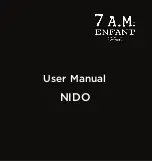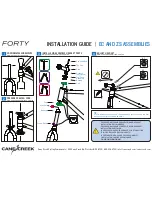
User's Guide ADI-8 DD © RME
3
1. Introduction
With the ADI-8 DD you have an incredibly versatile digital interface to your supply. What at first
looks like a simple AES/TDIF/ADAT format converter, turns out to be
the
universal problem
solver at a closer look. From small project studios to broadcast and television, the
Universal
Format Converter
is the perfect link between the formats mostly used today.
As a consequent continuation of RME's world-wide successful ADI-8 series, the DD also con-
tains elaborate technology and the latest integrated circuits, delivering 8 full channels in 24 bit
and 96 kHz. The ADI-8 DD is a uniquely powerful and high-quality device, which will excite you
even after many years of operation.
2. Package Contents
Please check that your ADI-8 DD package contains each of the following:
•
ADI-8 DD
•
Manual
•
Power chord
•
2 x 2 m optical cable (TOSLINK)
3. Brief Description and Characteristics
The ADI-8 DD consists of two 8-channel digital format converters in reference quality, in a stan-
dard 19" box with 1 unit height. The compact device has numerous extraordinary features like
Intelligent Clock Control (ICC), SyncCheck
®
, SyncAlign
®
, Bitclock PLL, patchbay functionality
and active jitter suppression per SD-PLL. Switchable high-end sample rate converters (SRC)
allow for both sample rate conversion in best possible quality, as well as clock-decoupling of all
AES/EBU inputs.
All of the ADI-8 DD's I/Os support 96 kHz/24 bit. As ADAT optical and TDIF are restricted to
48kHz, in DS mode (Double Speed) two channels are being used for the transmission of one
channel's data. The
Sample Split
algorithm used is also implemented in RME's Hammerfall and
Hammerfall DSP. Thus the ADI-8 DD also serves as an ideal AES/EBU frontend for these in-
terface cards, on both Mac and PC.
The format conversion between AES/EBU and ADAT/TDIF operates in both directions at the
same time, both completely independent or intelligently coupled. LEDs of different colours
show the present state of incoming and outgoing signals and of the internal processing in a
clear way.
The unique Intelligent Clock Control (ICC) allows for a flexible use with internal clock (44.1, 48,
88.2 and 96 kHz), external word clock or the digital input signals. These options being available
for both directions are intelligently coupled in a way typical for RME and easy to apply thanks to
a clear and easily understandable display of the Lock and Sync states. Besides, the unique
Copy Mode
allows for operation as digital patchbay and signal distributor. Up to 16 channels
can be distributed and converted at the same time. In few words: The ADI-8 DD is a true
Intelli-
gent Audio Solution
.




































